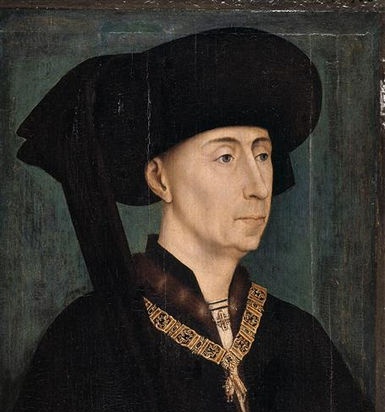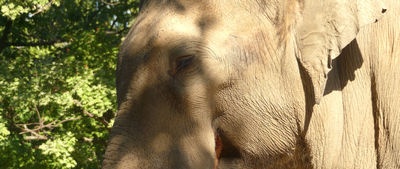|
 In 1190, during a fierce battle between the crusaders of Frederick Barbarossa and the Saracens, the war elephants of Sultan Saladin moved to the positions of the knights. Confusion gripped the Western warriors. In 1190, during a fierce battle between the crusaders of Frederick Barbarossa and the Saracens, the war elephants of Sultan Saladin moved to the positions of the knights. Confusion gripped the Western warriors.
It seemed impossible to resist the mighty onslaught of the giants. And only the Dane Ole Blondy did not succumb to the general panic. He stepped forward and uttered the battle cry of the Danes: "Frangot!" Ole Blond's archers showered the elephants with white-hot arrows and forced them to turn back ...
This is the legend that explains the reason for the appearance of the unusual Order of the Elephant in northern Denmark.
It is also unusual because, unlike all other similar signs, it is not flat, but three-dimensional. The order is like a miniature sculpture. White enamelled and set with diamonds, the elephant figurine with a turret and a black driver is worn on a gold chain, the links of which are also in the shape of elephants.
 Historical documents first record the existence of the Order of the Elephant in 1458, under King Christian I. Historical documents first record the existence of the Order of the Elephant in 1458, under King Christian I.
It is curious that thanks to his unceremonious perseverance, Peter the Great's favorite, AD Menshikov, became the first in Russia to be awarded this rare order; the king himself received such an award only three years later.
The Russian grandee V.V.Dolgoruky received the Order of the Elephant three times. He first became its owner in 1713. In 1719, Dolgoruky became involved in the "case of Tsarevich Alexei," and the order was returned to Copenhagen. In 1726, the disgrace ended, the Order of the Elephant again made its way from the Danish capital to St. Petersburg, but again not for long. In 1732, the field marshal again fined, was demoted and sent into exile, and only ten years later, again, for the third time, he received the ill-fated order.
Images of animals on orders of various states are not so rare. Most fortunate in this respect, of course, the king of animals - the lion and the king of birds - the eagle. Eagles white, black, red, gold, one-headed and two-headed, lying, standing on their hind legs, two-tailed, striped in the XIX century were the most popular decorations of state orders. Bear, owl, swan, swallow, and bee were less common. In 1890, Japan approved the military order of the Golden Falcon. The new highest order of the Democratic Republic of the Congo (now the Republic of Zaire) was the Order of the Leopard on the sixth anniversary of its independence.
It would be naive to believe that before the appearance of orders and medals in their present, familiar form for us, there were no other insignia.
The North American prairie Indians wore eagle-plumed headbands, each of which celebrated some courageous deed by the wearer. In addition, the different color of the feathers and the way in which they were trimmed had their strictly defined meaning.
 The red feathers of parakeets were a sign of the supreme power of the leaders of the island of Tahiti. Members of the leader's family on the island of Porapora were entitled only to the order of the second, so to speak, degree - a belt of yellow feathers. On the island of New Guinea, only a chief could wear a headdress decorated with parrot feathers. The long emerald feathers of the sacred bird quetzal were worn on the headdresses of the Mayan kings and high priests. The red feathers of parakeets were a sign of the supreme power of the leaders of the island of Tahiti. Members of the leader's family on the island of Porapora were entitled only to the order of the second, so to speak, degree - a belt of yellow feathers. On the island of New Guinea, only a chief could wear a headdress decorated with parrot feathers. The long emerald feathers of the sacred bird quetzal were worn on the headdresses of the Mayan kings and high priests.
Among the Melanesians, only a leader could wear a sperm whale tooth on his chest.
The "estate order" could also be called a tattoo on the arm, which distinguished translators in ancient Carthage. These essential specialists (people of more than sixty nationalities lived in Carthage) enjoyed great respect and were freed from all heavy work. The tattoo depicted a parrot. The one speaking one language had a parrot with folded wings, a polyglot translator with unfolded wings.Thus, here, too, the "order" was subdivided into two degrees.
For two thousand years BC in China, an ordinary umbrella served not so much for protection from rain or sun, but as an indicator of the high position and nobility of the owner. And in the 18th century AD, Lorenz Lang, who traveled to Beijing in 1715-1716, wrote in his diary: “All tangerines, from the highest to the lowest, were, according to Chinese custom, beautifully dressed in the best Kamchatka with patterns and all sorts of images of gold in the form of dragons, lions, snakes, mountains, valleys, trees, etc. On their outer clothing on the chest and back was seen a small breastplate with various animals and birds embroidered. By them it was possible to find out the official position of each. On the clothes of the officers there were lions, tigers, leopards, etc. Scientists who had the title of Doctor of Writing wore peacocks, etc. "
The use of scarabs in ancient Egypt - beetles carved from stone, bone or wood - was distinguished by an extraordinary variety. They served as amulets, signs of ownership, seals. So, they had their own scarabs for sealing temples, barns and warehouses. The royal tombs of the Necropolis in Thebes were sealed with a large scarab depicting a lying jackal and captives.
In connection with the conversation about orders, we are primarily interested in memorial scarabs, which may well be comparable with commemorative medals of our time.
They became widespread during the New Kingdom period. The earliest memorial scarabs were made to commemorate the completion of the two obelisks in honor of the god Amun at Karnak. A lot of memorial scarabs were released under Amenhotep III. Intending to marry a woman of an ordinary family and seeking to exalt her, this pharaoh ordered to make a mass of scarabs with messages about the upcoming wedding. The same Amenhotep released large (up to 8 centimeters) scarabs on the occasion of the construction of a large lake for his beloved wife, as well as to commemorate his hunting trophies — the 170th wild bull and the 102nd lion. In total, over a hundred memorial scarabs are registered in the collections stored in different countries of Europe and America.
 So, bird feathers, a tattooed parrot of Carthage, insignia of Chinese mandarins, and finally, memorial scarabs of Egypt ... Of course, this list cannot claim to be complete: there were many more predecessors in modern orders and medals. In confirmation, there are a few more examples. So, bird feathers, a tattooed parrot of Carthage, insignia of Chinese mandarins, and finally, memorial scarabs of Egypt ... Of course, this list cannot claim to be complete: there were many more predecessors in modern orders and medals. In confirmation, there are a few more examples.
The long claws from the front paws of armadillos served as a sign of power among the leaders of some Indian tribes.
In mountainous Nepal, it is still believed that the owner of a tiger's collarbone is a great man who has the right to command.
The claw and fang of the leopard are "orders" that distinguish in a number of African countries people who are vested with power over their own kind and have subordinates.
Aleut hunters in the past adorned their headdresses with the mustache of a sea lion, a sea lion. It was enough to count them to determine how many pinnipeds this or that hunter got in his life, and in accordance with this - and the degree of his nobility.
Among the African Maasai tribe, only the most skilled hunters have the right to wear ostrich feathers. However, victory in single combat with the king of beasts is considered the highest valor among the Masai. The hero is distinguished by a headdress with a lion's tail. But in the Elmolo tribe, a man who single-handedly defeated a hippopotamus, as a sign of special distinction, wears his tooth in his ear.
Let us return, however, to the order - "a badge of distinction given out for some kind of merit" - in the form familiar to you and me.
If the Danish Order of the Elephant is known for its unusual form, then the Order of the Golden Fleece found itself in the center of political passions that raged at once in many European states - the Netherlands, Spain, the Austrian Empire and France ...
The order depicts a lamb skin with a horned head and legs.It was founded by Philip III the Good, Duke of Burgundy and the Netherlands, on the occasion of his marriage to Isabella of Portugal in 1429 in the city of Bruges. Why is the sign named specifically the Order of the Golden Fleece? There are several versions about this.
One of the members of the ducal house was very unlucky: he was captured and was brought by fate to Colchis. But it was just to Colchis, according to the Greek myth, that the Argonauts sailed, led by Jason, to take possession of the golden fleece! The offspring of a noble family managed to happily get rid of captivity, and in honor of this memorable event, legend says, Philip III established his new order.
Another legend connects the history of the origin of the order with the following amusing incident. Once a golden-haired court dump from the duke's retinue flew out of the saddle at full gallop. To Philip III, a lover and connoisseur of ancient myths, the incident reminded of the fall of Hella from the back of the golden fleece ram sent by Zeus to carry the children of the Boeotian king Atmant across the sea. The golden-haired blonde got off with a slight fright, but a new order appeared on the council.
 The closest to the truth, apparently, are not these legends, but one completely prosaic circumstance: the Netherlands, like nothing else, enriched the trade in the famous Flanders cloth, made, as you know, from sheep's wool - what is not the golden fleece! The closest to the truth, apparently, are not these legends, but one completely prosaic circumstance: the Netherlands, like nothing else, enriched the trade in the famous Flanders cloth, made, as you know, from sheep's wool - what is not the golden fleece!
In 1477, the Order of the Golden Fleece, together with the Netherlands, became the property of the Austrian Habsburgs. Later, the Habsburgs also established themselves on the throne of Spain, but in 1521 the vast and fragile empire collapsed, and the Netherlands became the possession of the Spanish branch of the Habsburgs.
The last Spanish Habsburg, Charles I, died in 1700 and the War of the Spanish Succession broke out immediately. The bone of contention in this legacy was the wealthy Netherlands, whose symbol was still the old Burgundian Order of the Golden Fleece.
In 1703, the Austrian pretender to the Spanish throne Charles VI Joseph-Franz managed to capture Madrid. True, the Spaniards quickly escorted him out of there, but, getting out of his way, the applicant contrived to take the order's archive to Vienna. So Joseph-Franz turned out to be his undivided master. Later, the Austrians conquered the Netherlands from Bourbon Spain, which further strengthened the "right" of the Habsburgs to own the Order of the Golden Fleece.
Nevertheless, Spain continued to consider the order its own after the end of the war, in which it was defeated. For several decades, the Golden Fleece has been the subject of bitter litigation between two stakeholders. The litigation was finally crowned by a compromise that established the order of dual ownership. This is how the Spanish and Austrian variants of the insignia of the Order of the Golden Fleece appeared.
For a long time, the old Burgundy award had great international weight. It is no accident that Napoleon I, being at the zenith of glory and power, intended to establish the highest military order of the Three Golden Fleeces: it was supposed to symbolize the rule of the French over Spain and the Netherlands and the alliance with the Austrian Habsburgs.
And in conclusion, we will tell you about one not quite ordinary souvenir medal, which has been minted by the mint in the Austrian capital Vienna for more than a dozen years in a row especially for the New Year holiday. The medal depicts a chubby kid riding ... a pig. What does the pig have to do with it? The answer is simple: among the Austrians (and in Germany too) since ancient times the pig was considered a symbol of good luck.
Krasnopevtsev V.P. - Seagulls on a pedestal
|
 In 1190, during a fierce battle between the crusaders of Frederick Barbarossa and the Saracens, the war elephants of Sultan Saladin moved to the positions of the knights. Confusion gripped the Western warriors.
In 1190, during a fierce battle between the crusaders of Frederick Barbarossa and the Saracens, the war elephants of Sultan Saladin moved to the positions of the knights. Confusion gripped the Western warriors. Historical documents first record the existence of the Order of the Elephant in 1458, under King Christian I.
Historical documents first record the existence of the Order of the Elephant in 1458, under King Christian I. The red feathers of parakeets were a sign of the supreme power of the leaders of the island of Tahiti. Members of the leader's family on the island of Porapora were entitled only to the order of the second, so to speak, degree - a belt of yellow feathers. On the island of New Guinea, only a chief could wear a headdress decorated with parrot feathers. The long emerald feathers of the sacred bird quetzal were worn on the headdresses of the Mayan kings and high priests.
The red feathers of parakeets were a sign of the supreme power of the leaders of the island of Tahiti. Members of the leader's family on the island of Porapora were entitled only to the order of the second, so to speak, degree - a belt of yellow feathers. On the island of New Guinea, only a chief could wear a headdress decorated with parrot feathers. The long emerald feathers of the sacred bird quetzal were worn on the headdresses of the Mayan kings and high priests. So, bird feathers, a tattooed parrot of Carthage, insignia of Chinese mandarins, and finally, memorial scarabs of Egypt ... Of course, this list cannot claim to be complete: there were many more predecessors in modern orders and medals. In confirmation, there are a few more examples.
So, bird feathers, a tattooed parrot of Carthage, insignia of Chinese mandarins, and finally, memorial scarabs of Egypt ... Of course, this list cannot claim to be complete: there were many more predecessors in modern orders and medals. In confirmation, there are a few more examples. The closest to the truth, apparently, are not these legends, but one completely prosaic circumstance: the Netherlands, like nothing else, enriched the trade in the famous Flanders cloth, made, as you know, from sheep's wool - what is not the golden fleece!
The closest to the truth, apparently, are not these legends, but one completely prosaic circumstance: the Netherlands, like nothing else, enriched the trade in the famous Flanders cloth, made, as you know, from sheep's wool - what is not the golden fleece!









